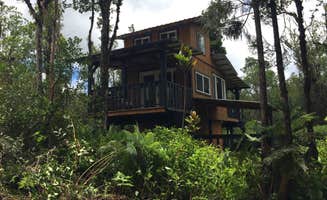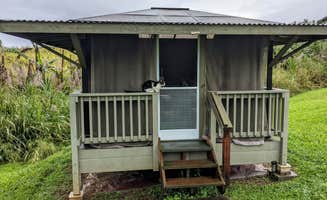Cabin camping near Hawaiian Paradise Park offers accommodations across diverse elevation zones, from sea level to the 4,000-foot volcanic highlands near Hawai'i Volcanoes National Park. The Puna district's tropical climate creates dramatically different conditions between coastal and upland cabins, with higher elevation locations experiencing nighttime temperatures in the low 60s. Solar power systems operate many off-grid cabin facilities, providing basic electricity with specific operational hours.
What to do
Volcano viewing hikes: Nāmakanipaio Campground provides an ideal base for exploring lava fields. "The best entrance to see the volcano at night is a bit of a drive/back ride but well worth it! Talk to locals in Pahoa and Keaau for tips on how to see the best views of the volcano," shares one Nāmakanipaio visitor.
Native plant exploration: Kalopa State Recreation Area offers unique botanical experiences. "Awesome hiking/running trails, many native plant species difficult to find elsewhere," notes a visitor who appreciated the upland forest setting.
Bird watching: The diverse habitats around cabin sites attract numerous bird species. "So many birds and other loud creatures singing all night long," reports one guest at Arnotts Lodge and Hiking Adventures, highlighting the natural soundtrack that accompanies stays in this area.
What campers like
Temperature variation: The higher elevation cabins provide respite from coastal heat. "The higher altitude kept the temperatures in the low 60's and perfect for sleeping," explains one Nāmakanipaio camper who appreciated the cooler mountain climate.
Proximity to volcanic features: Nāmakanipaio Campground cabins allow close access to geologic wonders. "Pretty epic experience sleeping so close to Pele," remarks one visitor who enjoyed the volcano-adjacent location.
Pavilion facilities: Shared cooking and gathering spaces enhance the cabin experience. "There was a pavilion with a stone fireplace that was very attractive for groups," notes a Nāmakanipaio visitor who appreciated the communal spaces available beyond individual cabins.
What you should know
Early arrival importance: Cabin availability can be extremely limited without reservations. "Super friendly people and beautiful area! We showed up in the early afternoon and got the last spot available but only because the original person who got it had upgraded to a cabin," explains a Nāmakanipaio visitor.
Solar power limitations: Hamakua Guesthouse & Camping Cabanas operates on renewable energy with specific hours. "Note, the power goes off at 10pm, as the whole compound runs on solar power and batteries," advises a guest who stayed in their unique hammock accommodations.
Temperature fluctuations: Pack appropriate clothing for significant day-night temperature shifts. "I say desert, because it can get so hot during the day and turn around and get really cold at night," warns a Nāmakanipaio visitor about the sometimes surprising climate conditions.
Tips for camping with families
Age restrictions: Check facility policies before booking with young children. "Children under 7 not allowed," notes a visitor at Arnotts Lodge, highlighting an important consideration for families seeking cabin accommodations.
Rain preparation: Bring appropriate gear for potentially heavy precipitation. "It was raining buckets the night we stayed there, but we were dry and comfortable, although torrential rain on any small structure might make sleeping a challenge," shares a Hamakua Guesthouse visitor.
Food planning: Limited grocery options near cabin sites require advance meal planning. "No stores or restaurants in walking distance," reports an Arnotts Lodge guest, emphasizing the importance of bringing supplies.
Tips from RVers
Limited hookups: Most cabin areas have minimal RV infrastructure. "Nice, open sites with decent amenities," notes a Lava Rock Glamping visitor, though the facilities focus primarily on tent and cabin campers rather than providing comprehensive RV services.
Park entrance considerations: RV access to some cabin areas involves navigating park fee stations. "The campground is technically outside of the national park and if you hike in there is no park fee," explains a Nāmakanipaio camper about the unique boundary situation that affects vehicle access.
Space limitations: Many cabin areas have limited parking for larger vehicles. "Very quiet location with nearby access to incredible hiking," notes a Nāmakanipaio visitor who found the compact nature of the site contributed to its peaceful atmosphere.



